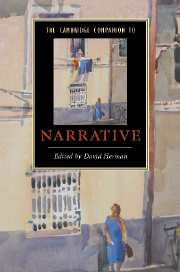Book contents
- Frontmatter
- Part I Preliminaries
- Part II Studying narrative fiction: a starter-kit
- Part III Other narrative media (a selection)
- Part IV Further contexts for narrative study
- 13 Gender
- 14 Rhetoric/ethics
- 15 Ideology
- 16 Language
- 17 Cognition, emotion, and consciousness
- 18 Identity/alterity
- Glossary
- Further reading
- Index
14 - Rhetoric/ethics
from Part IV - Further contexts for narrative study
Published online by Cambridge University Press: 28 September 2007
- Frontmatter
- Part I Preliminaries
- Part II Studying narrative fiction: a starter-kit
- Part III Other narrative media (a selection)
- Part IV Further contexts for narrative study
- 13 Gender
- 14 Rhetoric/ethics
- 15 Ideology
- 16 Language
- 17 Cognition, emotion, and consciousness
- 18 Identity/alterity
- Glossary
- Further reading
- Index
Summary
The rhetorical approach conceives of narrative as a purposive communicative act. In this view, narrative is not just a representation of events but is also itself an event - one in which someone is doing something with a representation of events. More formally, the rhetorical theorist defines narrative as somebody telling somebody else on some occasion and for some purpose(s) that something happened. This conception has several significant consequences for the kinds of knowledge about narrative the approach seeks. It gives special attention to the relations among tellers, audiences, and the something that has happened. The focus on purposes includes a recognition that narrative communication is a multi-layered event, one in which tellers seek to engage and influence their audiences' cognition, emotions, and values. Moreover, the approach recognizes that, in telling what happened, narrators give accounts of characters whose interactions with each other have an ethical dimension and that the acts of telling and receiving these accounts also have an ethical dimension. Consequently, the rhetorical approach attends to both an ethics of the told and an ethics of the telling.
In this chapter, I want to elaborate on these points and to demonstrate what rhetorical interpretation of narrative looks like. Therefore, I will first offer a brief, partial analysis of Edgar Allan Poe's “The Cask of Amontillado,” and then turn to a short account of the approach's historical evolution. From there I will go on to elaborate its main underlying principles, a move that will also prepare the way for a return to Poe's story and a completion of the rhetorical analysis.
- Type
- Chapter
- Information
- The Cambridge Companion to Narrative , pp. 203 - 216Publisher: Cambridge University PressPrint publication year: 2007
- 22
- Cited by

